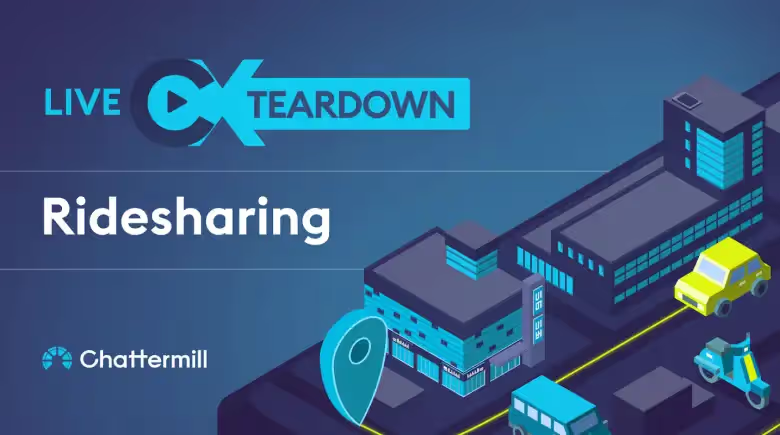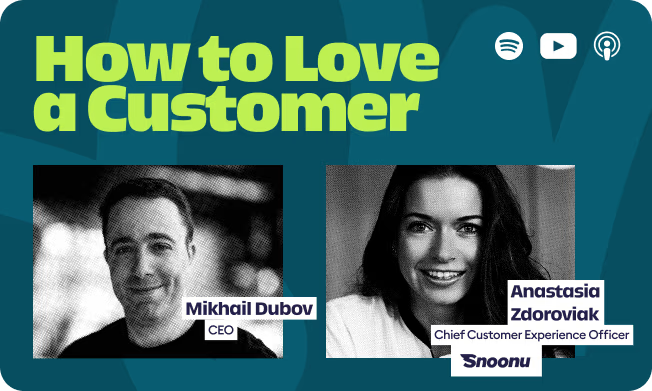Who’s winning the ridesharing wars?
Our CRO Luke Moore, co-founder and insights specialist Dmitry Isupov, and senior CX specialist Romy Saville took a deep dive into the ridesharing market to find out, in our first ever CX teardown.
Ridesharing is, as we know, a fast-evolving marketplace. And customer experience is arguably the hottest contested area, with all brands fighting it out with each other to win and retain customers.
Using hundreds of thousands of data points to dig down into each key area of customer experience – from surge pricing to car availability – and compare the two key user groups – drivers and passengers – we found out who the real winners and losers are.
Read on for our key takeaways from the webinar. As always, the full discussion – as well as the Q&A – is available to watch below.

LIVE CX Teardown: Ridesharing - Chattermill
Ridesharing: who’s winning and losing?
When looking at overall brand sentiment from the market, Dmitry Isupov notes that we are still seeing a lot of fallout from the pandemic period.

With a high-level view of customer sentiment in-app reviews, Bolt has managed to remain on top in the past 12 months – despite seeing a drop from typically positive sentiment to more negative sentiment in 2022.
We can also see that market-leader Uber receives more negativity overall than Bolt, Careem and Lyft. But the fact that it has managed to remain stable on -47 is quite remarkable.
It’s important to remember that app reviews are more likely to be inherently negative. Customers are more inclined to post feedback to vent their frustrations, rather than to share their positive experiences. With this in mind, it’s important to note steady upward trends by the likes of FREE NOW relative to the fluctuations we are seeing amongst other brands.
How do ridesharing brands perform on price?
Pricing is really important to rideshare customers and it’s a bit of a mixed bag in terms of where the brands in our study win and lose.

Lyft, overall, is seen as the most expensive rideshare app – but customers are generally more amenable to their relatively low cancellation fees and their use of promotions/discounts.
FREE NOW – as we can see – is not performing well for customer sentiment in relation to price estimation and promotions/discounts. Isupov points to tech limitations within the app which the brand has been seen to be addressing (and which is reflected in our earlier graph which showed overall sentiment to be improving).
Additionally, cancellation fees see some negative fallout for Uber and FREE NOW. Clearly, cancellations can be a big frustration for some customers.
Which ridesharing brand offers the best availability?
When it comes to pickup ETAs and wait times, Bolt is a clear winner.

At the other end of the scale, sentiment for Uber is comparatively low. Almost all mentions of wait times are negative – perhaps because of driver availability relative to demand.
There is a big opportunity for other brands to get ahead of Uber here – to double down on ensuring there are enough drivers to get to customers promptly.
Which ridesharing brands have the best/worst drivers?
Lyft is a big winner in terms of attitude and etiquette according to their customers. There’s a lot of genuine praise – with passengers feeling safe and welcomed by the drivers in their vehicles.

Bolt also performs well across attitude/etiquette and ride quality, while Uber and Careem receive mostly negative sentiment here.
When it comes to cancellation/gaming, Uber and FREE NOW get the most negative commentary about their drivers.
Which ridesharing brands are winning and losing on vehicle quality?
Lyft is, again, a strong winner here – with a considerable volume of positive praise for cleanliness of their vehicles.

Bolt and FREE NOW also receive a lot of positive reviews. While Uber, interestingly, performs the worst across cleanliness and quality/condition of their cars.
Which ridesharing brand has the worst communication?
Here, FREE NOW suffers from a considerable amount of negative sentiment towards the technical limitations of its app.
Across notifications/confirmations, the ability to communicate with the driver, and app responsiveness – are clearly the biggest frustrations to customers compared with other brands in our study.

By comparison, market-leader Uber does relatively OK for sentiment around its communications experience and Bolt, again, is the clear winner.
The CX teardown: an in depth analysis of ridesharing CX
Bolt is setting a high standard across the average score within app reviews.
‘Naturally, prices and rates are really important,’ Romy Saville says. ‘Price-surging attracts negativity across the board. Sometimes drivers cancel then prices surge when they rebook. Sometimes surges happen during a ride.’
It’s easy to see how this can be frustrating to customers. But we can also see how crucial it is for brands to be able to be agile with their pricing as demand fluctuates. So what can be done?
Luke Moore believes there are three ways rideshare brands can approach this to ensure customers are getting the best experience possible. ‘Number one: Maximum transparency,’ he says, ‘once a passenger books a ride, keep the ride at a fixed cost throughout the journey where possible.’
‘Number two,’ Moore continues. ‘When a driver cancels a ride, particularly after a wait time of a particular threshold, keep the cost of the journey consistent. This is where perhaps you could use discount codes.’
On the point of using surge pricing… ‘Keep this to reasonable rates that still align to competitors,’ he says.
Saville notes that the lack of discount codes is very closely linked to disloyal customers for rideshare brands. ‘The trend with companies with high net sentiment and also with discount codes is quite strong,’ she says.
We can see Bolt is clearly winning with the overall trend for discounts as well as digging into specific comments left in the app reviews. They are a relatively simple way to promote loyalty, with brands making “Take this trip and get the next one discounted/free” offers to ensure customers will log in again the next time they need a ride.
What’s driving the most negativity across the ridesharing industry overall?
Isupov, Saville and Moore agree that car availability, cancellations, gaming and pick-up wait times are all the root causes of a lot of negative sentiment – and all these relate more to drivers than the apps themselves.
An important takeaway for brands, here, is: If your drivers aren’t having a good experience they won’t be passing this down to passengers. They will be more likely to log into a competitor app in the first place and they will be more likely to cancel or keep passengers waiting.
In response to this, we can see rideshare brands are trying to offer better, unique benefits to drivers – from gym membership to insurance – to keep them loyal.
The value of Unified Customer Intelligence to ridesharing brands
This teardown focused only on publicly available app reviews. This data is a useful barometer but is only really a (passenger-centric) snapshot of the full ridesharing ecosystem.
Unified Customer Intelligence (UCI) platforms such as that offered by Chattermill allow us to pull in data from elsewhere, too. For example, surveys, tickets, live chats, reviews – so you can understand the full customer journey and pinpoint the touchpoints causing the most friction for customers.

It’s also key to understand the points that customers love, so as not to accidentally get rid of features that users find important.
UCI is also crucial for helping brands segment across different user groups.
Read: Optimising Ridesharing Customer Experience Starts with Unified Customer Intelligence
‘The issues that your drivers face are going to be very different from those faced by your passengers,’ Saville says. ‘So it’s super important to be able to distinguish between them. You can then tailor your approaches accordingly.’
Alongside being able to distinguish between CX expectations of drivers and passengers, users in different locations can have different customer experience needs too. UCI can even pull out data for CX for certain vehicle types – which is especially useful as rideshare brands move to diversify the modes of transport they have available.
Customer experience in ridesharing is full of nuances and variables. But the voice of the customer (and the drivers) is there, and brands need to be listening to ensure they can compete as the market continues to move.
Watch The Ridesharing Teardown Again
















